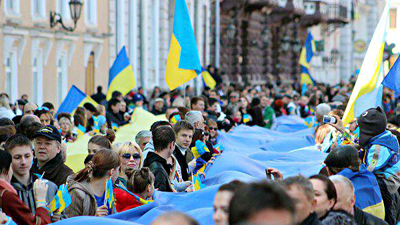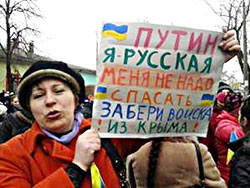(lead article)
Ukrainians answer Moscow
provocations in east, south
Ukraine rulers, IMF foist debt burden on workers


| Euromaiden |
|
Above, 10,000 march in Odessa, Ukraine, March 30 with half-mile-long Ukrainian flag in support of Ukraine’s sovereignty. Inset, woman at March 8 protest in Crimea. Sign reads, “Putin, I’m Russian. You don’t need to save me. Get your troops out of Crimea!”
|
BY JOHN STUDER
Small armed bands backed by Moscow stormed government buildings in the Ukrainian cities of Donetsk, Lugansk and Kharkiv April 6 and Mykolayiv the following day in provocations designed to lay the groundwork for possible Russian intervention.
Roughly 100 pro-Moscow agents occupied the regional government administration building in Donetsk near Ukraine’s eastern border. They declared a “People’s Republic of Donetsk,” announced they would organize a referendum May 11 on separation from Ukraine and called on Russian President Vladimir Putin to send troops, some 40,000 of which are amassed near the border.
A similar number seized the local Security Service of Ukraine office in Lugansk, where they broke into an armory and seized AK-47 assault rifles.
A group of pro-Moscow agents also seized the Security Service of Ukraine office in the northeastern city of Kharkiv, but were pushed out two days later by elite Ukrainian units, who arrested 70.
“Police were doing nothing at all, they were just walking amid the thugs,” Zinoviy Flionts, an eyewitness in Kharkiv, told the Kyiv Post. “The guys who took over the administration were either some Russians or simply criminals brought from somewhere.”
On the night of April 7, similar forces attempted to take over the administration building in the southern city of Mykolayiv, but were repulsed by local volunteer self-defense units.
The operations echo the provocations that prepared Moscow’s invasion of Crimea, which was followed by a rigged referendum at gunpoint March 16 and seizure of the peninsula. Since then, thousands of Crimean residents — Tatars, ethnic Ukrainians and others — have left the peninsula. More than 1,000 families in Ukraine have opened their homes to receive the refugees.
“There is a script being written in the Russian Federation, for which there is only one purpose: the dismemberment and destruction of Ukraine and the transformation of Ukraine into the territory of slavery under the dictates of Russia,” Ukrainian Interim Prime Minister Arseniy Yatsenyuk said April 7.
These moves do not represent any “sharp rise in tension” in the majority Russian-speaking east of Ukraine, the Kharkiv Human Rights Group said April 7. This is reflected in the “relatively small numbers involved,” the group said, and flies in the face of recent polls and demonstrations in the region showing majority sentiment for Ukraine unity.
The Donbass News published an open letter from people in the city urging the interim Ukrainian government to “deal with the indecisive actions by local authorities” to counter threats to “Ukrainian sovereignty, territorial integrity and Constitutional order.”
Some 10,000 marched in Odessa against pro-Moscow provocations March 30, carrying a half-mile-long Ukrainian flag. A march in support of the Russian government the same day there drew 3,000.
Meanwhile, the interim Ukrainian government is pressing ahead with plans to slash state expenses and make Ukrainian capital “more competitive” on the back of working people as part of a deal for usurious loans from the International Monetary Fund. Yatsenyuk told Reuters they intend to double gas prices and freeze state salaries and pensions. “We will regain trust and credibility from foreign investors,” he said. “This is the roadmap for Ukraine.”
The rulers of Ukraine, Russia and the U.S. have but one point of agreement: the desire to bring an end to the mobilization of working people in Ukraine. The Ukrainian parliament voted unanimously April 1 to disarm “paramilitary groups” — targeting the thousands who remain in Kiev’s Independence Square, the center of mobilizations across the nation that overthrew the pro-Russian regime of Viktor Yanukovych in February.
Secretary of State John Kerry said March 30 that he and Russian Foreign Minister Sergey Lavrov agreed on the need to work with the Ukrainian government to assure “demobilization and disarmament of irregular forces and provocateurs.”
At the same time, several new bills were introduced in the Russian Duma to “prevent the kind of street demonstrations that gripped Ukraine’s Kiev,” USA Today reported April 6. One proposal would authorize the cops to use lethal force against civilian protesters.
Related articles:
Cuba’s aid to victims of Ukraine nuclear disaster ‘is unparalleled’
Miners in eastern Ukraine refute press in Russia, US
| 


